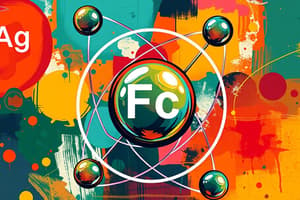Podcast
Questions and Answers
What is the main reason why atoms tend to gain, lose, or share electrons?
What is the main reason why atoms tend to gain, lose, or share electrons?
- To achieve a full outer shell of eight electrons. (correct)
- To achieve a full outer shell of twelve electrons.
- To achieve a full outer shell of ten electrons.
- To achieve a full outer shell of six electrons.
What is the difference between ionic and covalent bonds?
What is the difference between ionic and covalent bonds?
- Ionic bonds involve the transfer of protons, while covalent bonds involve the sharing of electrons.
- Ionic bonds involve the transfer of electrons, while covalent bonds involve the sharing of neutrons.
- Ionic bonds involve the transfer of electrons, while covalent bonds involve the sharing of electrons (correct)
- Ionic bonds involve the transfer of neutrons, while covalent bonds involve the sharing of electrons.
What is the main characteristic of a polar covalent bond?
What is the main characteristic of a polar covalent bond?
- Electrons are shared unequally between atoms. (correct)
- Electrons are not shared between atoms.
- Electrons are shared equally between atoms.
- Electrons are shared only between ions.
What is the shape of the water molecule?
What is the shape of the water molecule?
What is the result of the unequal sharing of electrons in a polar covalent bond?
What is the result of the unequal sharing of electrons in a polar covalent bond?
What is the main reason why water molecules can dissolve a wide range of substances?
What is the main reason why water molecules can dissolve a wide range of substances?
What is the strength of hydrogen bonds compared to covalent bonds?
What is the strength of hydrogen bonds compared to covalent bonds?
Why are hydrophobic materials not soluble in water?
Why are hydrophobic materials not soluble in water?
What is the primary function of the cell membrane (plasma membrane)?
What is the primary function of the cell membrane (plasma membrane)?
What is the significance of water's high specific heat capacity?
What is the significance of water's high specific heat capacity?
Flashcards are hidden until you start studying
Study Notes
Atomic Structure
- Atoms are composed of three main particles: protons, neutrons, and electrons
- Protons have a positive charge, neutrons have no charge (neutral), and electrons have a negative charge
Isotopes and Ions
- An isotope is a variant of a chemical element that differs in neutron number, having the same number of protons
- An ion is an atom or molecule with a positive (cation) or negative (anion) electrical charge due to the loss or gain of one or more electrons
Chemical Bonds
- Ionic bonds: formed when one or more electrons are transferred from one atom to another, resulting in positively and negatively charged ions that attract each other
- Covalent bonds: formed when atoms share electrons to achieve a stable electron configuration
- Types of covalent bonds:
- Polar covalent bonds: electrons are shared unequally between atoms, resulting in partial positive and negative charges
- Nonpolar covalent bonds: electrons are shared equally between atoms, resulting in no net charge
Water Molecule Structure and Properties
- Water molecule (H2O) has a bent shape, with two hydrogen atoms covalently bonded to an oxygen atom
- Polarity of water molecules: oxygen atom is more electronegative, creating a partial negative charge (δ-) and partial positive charges (δ+) on hydrogen atoms
- Formation of hydrogen bonds: positively charged hydrogen atoms in one water molecule are attracted to negatively charged oxygen atoms in neighboring water molecules
- Strength of hydrogen bonds: weaker than covalent or ionic bonds, but significant and crucial for structural stabilization
- Properties of water: high surface tension, cohesion, adhesion, and ability to dissolve a wide range of substances
pH and Acidity
- pH is a measure of the acidity or basicity of a solution, related to the concentration of hydrogen ions
- More hydrogen ions result in a more acidic solution
Hydrogen Bonding and Biological Significance
- Hydrogen bonding is associated with properties such as surface tension, boiling point, and unique properties of water
- Hydrophobic materials are not soluble in water due to non-polar nature, while hydrophilic molecules are attracted to water and form favorable interactions
- Water is essential for life on Earth, serving as a solvent, regulating temperature, supporting habitats, transporting nutrients, and participating in metabolic processes
Cell Membrane (Plasma Membrane)
- Function: acts as a boundary between the cell's interior and external environment
Studying That Suits You
Use AI to generate personalized quizzes and flashcards to suit your learning preferences.




